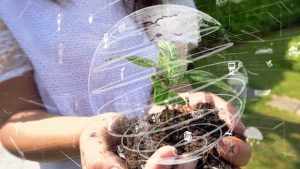

In today’s rapidly evolving world, the agricultural industry is undergoing a transformative shift. Traditional farming methods are being replaced by innovative techniques that harness the power of data and analytics to optimize crop production. This groundbreaking approach, known as precision agriculture, is revolutionizing the way farmers cultivate their land and maximize their yields.
By leveraging cutting-edge technology and harnessing the potential of data-driven insights, farmers are able to make informed decisions that enhance productivity and efficiency. Precision agriculture empowers farmers to monitor and analyze various factors that impact crop growth, such as soil quality, weather patterns, and pest infestations. Armed with this valuable information, farmers can tailor their farming practices to address specific challenges and capitalize on opportunities for growth.
The integration of advanced sensors, drones, and satellite imagery enables farmers to collect real-time data on crop health, moisture levels, and nutrient requirements. This data is then analyzed using sophisticated algorithms and machine learning techniques to generate actionable insights. By identifying patterns and trends, farmers can proactively address issues before they escalate, resulting in healthier crops and higher yields.
Moreover, precision agriculture promotes sustainable farming practices by minimizing the use of resources such as water, fertilizers, and pesticides. By precisely applying these inputs based on data-driven recommendations, farmers can reduce waste and environmental impact. This not only benefits the ecosystem but also improves the economic viability of farming operations.
In conclusion, precision agriculture represents a paradigm shift in the agricultural industry. By harnessing the power of data and analytics, farmers can optimize their farming practices, increase productivity, and contribute to a more sustainable future. With technology continuing to advance at an unprecedented pace, the potential for further innovation in precision agriculture is limitless, promising even greater efficiency and profitability for farmers worldwide.
The Role of Data in Precision Agriculture
Data plays a crucial role in the advancement of precision agriculture, revolutionizing the way farmers approach crop cultivation. By harnessing the power of data, farmers can make informed decisions, optimize resource allocation, and enhance overall crop productivity. This article explores the significance of data in precision agriculture and its impact on sustainable farming practices.
Unlocking Insights through Data Analysis
Data analysis is at the core of precision agriculture, enabling farmers to gain valuable insights into various aspects of crop cultivation. By collecting and analyzing data on soil composition, weather patterns, and crop growth, farmers can identify trends, patterns, and potential issues that may affect crop yields. This allows them to make data-driven decisions, such as adjusting irrigation schedules, applying fertilizers more efficiently, or implementing pest control measures at the right time. Through data analysis, farmers can optimize their farming practices and maximize crop yields while minimizing resource wastage.
Enhancing Decision-Making with Real-Time Data
Real-time data collection and analysis have revolutionized decision-making in precision agriculture. With the help of sensors, drones, and satellite imagery, farmers can gather data on crop health, moisture levels, and nutrient deficiencies in real-time. This immediate access to data empowers farmers to respond promptly to changing conditions and make timely interventions. For example, if a sensor detects a sudden drop in soil moisture, farmers can remotely activate irrigation systems to prevent crop stress. Real-time data also enables farmers to monitor the effectiveness of their interventions and make adjustments as needed, ensuring optimal crop growth and yield.
In conclusion, data plays a pivotal role in precision agriculture by providing valuable insights and enabling informed decision-making. Through data analysis and real-time monitoring, farmers can optimize their farming practices, conserve resources, and maximize crop yields. As technology continues to advance, the role of data in precision agriculture will only become more critical, driving sustainable and efficient farming practices for the future.
Utilizing Analytics for Crop Yield Optimization

Enhancing agricultural productivity through the strategic utilization of data-driven analytics is a key factor in optimizing crop yields. By harnessing the power of advanced analytics, farmers can gain valuable insights into various aspects of their crops, enabling them to make informed decisions and implement targeted strategies for maximizing yield potential.
One of the primary benefits of utilizing analytics in crop yield optimization is the ability to analyze and interpret vast amounts of data collected from various sources. By integrating data from weather patterns, soil composition, crop health monitoring systems, and historical yield records, farmers can gain a comprehensive understanding of the factors influencing crop growth and performance.
With the aid of analytics, farmers can identify patterns and trends in the data, enabling them to make data-driven decisions regarding irrigation, fertilization, pest control, and other critical aspects of crop management. By leveraging these insights, farmers can optimize resource allocation, minimize waste, and maximize the efficiency of their farming practices.
Furthermore, analytics can facilitate predictive modeling, allowing farmers to anticipate potential challenges and mitigate risks. By analyzing historical data and incorporating real-time information, farmers can develop predictive models that forecast crop yield outcomes under different scenarios. This enables them to proactively adjust their strategies and implement preventive measures to ensure optimal crop growth and yield.
Additionally, analytics can enable farmers to monitor crop health and detect early signs of disease or nutrient deficiencies. By leveraging remote sensing technologies and image analysis, farmers can identify subtle changes in crop appearance and health indicators, enabling them to take timely action to prevent or mitigate potential crop losses.
In conclusion, the utilization of analytics in crop yield optimization offers immense potential for farmers to make data-driven decisions, enhance resource allocation, and mitigate risks. By harnessing the power of analytics, farmers can maximize their crop yields, improve overall productivity, and contribute to the sustainable growth of the agricultural sector.
Implementing IoT and Sensor Technologies in Precision Farming

In the realm of modern farming practices, the integration of Internet of Things (IoT) and sensor technologies has revolutionized the way precision agriculture is implemented. By harnessing the power of interconnected devices and advanced sensors, farmers are able to gather real-time data and make informed decisions to optimize crop production.
The implementation of IoT and sensor technologies in precision farming involves the deployment of various devices and sensors throughout the agricultural landscape. These devices are equipped with sensors that collect data on a wide range of parameters, such as soil moisture levels, temperature, humidity, and nutrient content. This data is then transmitted wirelessly to a central system, where it is analyzed and processed to provide valuable insights for farmers.
One of the key advantages of implementing IoT and sensor technologies in precision agriculture is the ability to monitor and control farming operations remotely. Farmers can access real-time data from their fields through web-based platforms or mobile applications, allowing them to make timely decisions and take appropriate actions. For example, if a sensor detects low soil moisture levels, the farmer can remotely activate an irrigation system to ensure optimal water supply to the crops.
Furthermore, the integration of IoT and sensor technologies enables farmers to optimize the use of resources, such as water, fertilizers, and pesticides. By continuously monitoring the environmental conditions and crop health, farmers can apply these resources precisely and in the right quantities, minimizing waste and reducing environmental impact. This not only improves the overall efficiency of farming operations but also promotes sustainable agricultural practices.
In conclusion, the implementation of IoT and sensor technologies in precision farming has transformed the way farmers approach crop production. By leveraging interconnected devices and advanced sensors, farmers can gather real-time data, remotely monitor farming operations, and optimize resource utilization. This integration of technology and agriculture not only maximizes crop yields but also promotes sustainable and efficient farming practices.
Benefits and Challenges of Precision Agriculture
Precision agriculture offers a multitude of advantages and presents various challenges in the modern farming industry. This innovative approach to farming leverages advanced technologies and data-driven analytics to optimize crop production and improve overall agricultural practices. However, it also brings forth certain obstacles that need to be addressed for successful implementation.
- Increased Efficiency: Precision agriculture enables farmers to make informed decisions based on accurate data and analytics, leading to increased efficiency in resource allocation, such as water, fertilizers, and pesticides. By precisely targeting areas that require attention, farmers can optimize their inputs and minimize waste, resulting in cost savings and reduced environmental impact.
- Enhanced Crop Yields: By utilizing data and analytics, precision agriculture empowers farmers to monitor and manage their crops more effectively. This allows for timely interventions, such as adjusting irrigation schedules or applying specific treatments, to ensure optimal growth conditions. As a result, crop yields can be maximized, leading to improved profitability for farmers.
- Improved Sustainability: Precision agriculture promotes sustainable farming practices by minimizing the use of resources and reducing environmental impact. By precisely targeting inputs, farmers can minimize the application of fertilizers and pesticides, reducing the risk of pollution and preserving soil health. Additionally, optimized irrigation practices can help conserve water, a valuable and limited resource.
- Enhanced Decision-Making: The use of data and analytics in precision agriculture provides farmers with valuable insights and information to make informed decisions. By analyzing historical and real-time data, farmers can identify patterns, predict potential issues, and optimize their farming strategies. This enables proactive decision-making, leading to improved outcomes and increased profitability.
Despite the numerous benefits, precision agriculture also presents challenges that need to be overcome. One of the primary challenges is the initial investment required to adopt and implement the necessary technologies and infrastructure. The cost of acquiring and maintaining precision agriculture equipment, such as sensors, drones, and GPS systems, can be significant. Additionally, there may be a learning curve for farmers to understand and effectively utilize the data and analytics provided by these technologies.
Another challenge is the need for reliable connectivity and data management systems. Precision agriculture heavily relies on real-time data collection and analysis, which necessitates a robust and stable internet connection. Furthermore, managing and interpreting the vast amount of data generated can be complex and time-consuming. Farmers need to have the necessary skills and resources to handle and make sense of this data to derive actionable insights.
Lastly, there may be regulatory and privacy concerns associated with precision agriculture. As data collection and analysis become more prevalent in farming practices, ensuring the security and privacy of sensitive information becomes crucial. Farmers must comply with relevant regulations and implement appropriate measures to protect data from unauthorized access or misuse.
In conclusion, precision agriculture offers significant benefits in terms of increased efficiency, enhanced crop yields, improved sustainability, and enhanced decision-making. However, it also presents challenges related to initial investment, connectivity, data management, and regulatory compliance. Overcoming these challenges is essential to fully harness the potential of precision agriculture and maximize its impact on the farming industry.
Future Trends in Precision Agriculture
In the ever-evolving field of precision agriculture, there are several emerging trends that are set to shape the future of farming. These trends encompass advancements in technology, innovative approaches to data analysis, and the integration of artificial intelligence into agricultural practices.
One of the key trends in the future of precision agriculture is the continued development and adoption of sensor technology. Sensors play a crucial role in collecting data on various environmental factors such as soil moisture, temperature, and nutrient levels. These sensors provide farmers with real-time information, allowing them to make data-driven decisions and optimize their farming practices.
Another trend that is gaining momentum is the use of drones in agriculture. Drones equipped with high-resolution cameras and sensors can capture detailed images of crops, providing farmers with valuable insights into plant health, growth patterns, and potential pest infestations. This data can then be analyzed to identify areas that require attention, enabling farmers to take proactive measures to maximize crop yields.
Artificial intelligence (AI) is also set to revolutionize precision agriculture in the coming years. AI algorithms can analyze vast amounts of data collected from sensors, drones, and other sources to identify patterns, predict crop diseases, and optimize irrigation and fertilization schedules. By harnessing the power of AI, farmers can make informed decisions that result in higher crop yields and reduced resource wastage.
Furthermore, the future of precision agriculture will see an increased focus on sustainability and environmental stewardship. Farmers are increasingly adopting practices such as precision nutrient management, which involves applying fertilizers and other inputs in a targeted manner to minimize waste and environmental impact. Additionally, the integration of precision agriculture with renewable energy sources, such as solar power, can further enhance sustainability in farming practices.
In conclusion, the future of precision agriculture holds immense potential for maximizing crop yields and improving overall farming efficiency. Through the continued development of sensor technology, the use of drones, the integration of AI, and a focus on sustainability, farmers can leverage data and analytics to make informed decisions that optimize their farming practices and contribute to a more sustainable agricultural industry.





